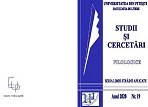LA VARIATION LINGUISTIQUE CHEZ BALZAC:
L’EXEMPLE D’ILLUSIONS PERDUES
THE LINGUISTIC
VARIATION IN BALZAC: EXAMPLE OF ILLUSIONS
PERDUES
Author(s): Mohamed BourasseSubject(s): Descriptive linguistics
Published by: Editura Universităţii din Piteşti
Keywords: "Linguistic variation"; "Illusions perdues"; "literary heteroglossia"; "Balzac";
Summary/Abstract: The present work can be considered to be a work in-between linguistics andliterature. It is a sociolinguistic reflection on the literary language of Balzac to understandtheliterary and linguistic issues of this writer. Since all literature is first of all an act oflanguage, the choice of this or that language of writing reveals the narrative and literarychoices of the writer. Thus, while reading Illusions perdues of Balzac, the first thing thatstrikes the reader is the extreme diversity of the language of his characters, through the useof a very diverse range of linguistic variants such as sociolects, idiolects, regiolects ...,phenomenon that some researchers like to call “literary heteroglossia”. All types ofvariation are scattered in the novel, affecting all linguistic levels. The characters thatstaged in the story constitute a true linguistic community which is characterized by itsheterogeneity, constituting a linguistic patchwork. All this lead us to study this linguisticvariation in this novel, in sociolinguistic terms as sociolinguistic markers, to understandhow and why Balzac uses this habit. To do so, it will be satisfying in this reflection to studythree types of variation that are of a big scale and that are very recurring compared to theothers types in Illusions perdues, and we will examine briefly the motivations that drove thewriter to resort to this variation and use it in his novel.
Journal: Studii şi cercetări filologice. Seria Limbi Străine Aplicate
- Issue Year: 2020
- Issue No: 19
- Language: French

